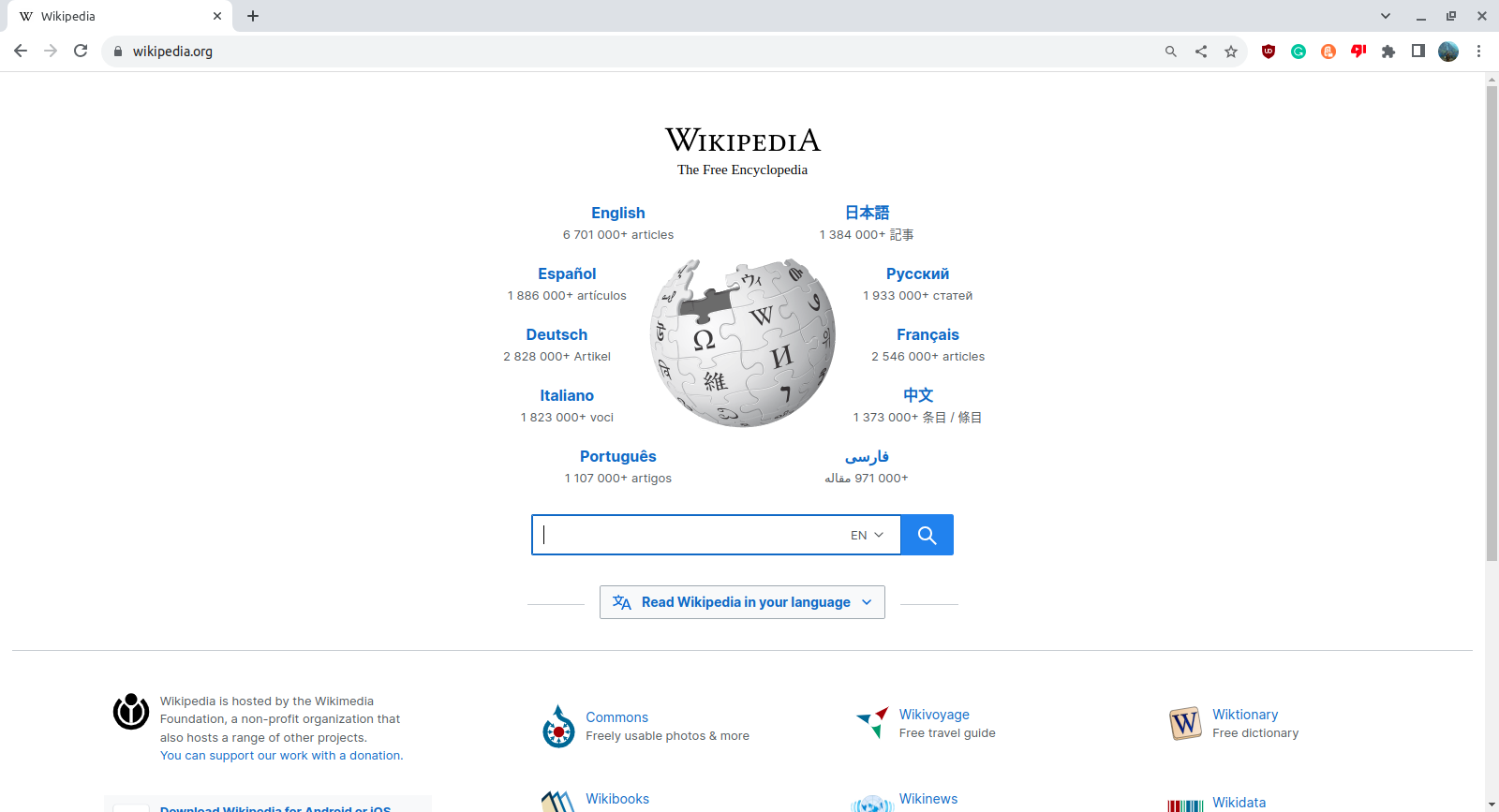|
HTTP
HTTP (Hypertext Transfer Protocol) is an application layer protocol in the Internet protocol suite model for distributed, collaborative, hypermedia information systems. HTTP is the foundation of data communication for the World Wide Web, where hypertext documents include hyperlinks to other resources that the user can easily access, for example by a Computer mouse, mouse click or by tapping the screen in a web browser. Development of HTTP was initiated by Tim Berners-Lee at CERN in 1989 and summarized in a simple document describing the behavior of a client and a server using the first HTTP version, named 0.9. That version was subsequently developed, eventually becoming the public 1.0. Development of early HTTP Requests for Comments (RFCs) started a few years later in a coordinated effort by the Internet Engineering Task Force (IETF) and the World Wide Web Consortium (W3C), with work later moving to the IETF. HTTP/1 was finalized and fully documented (as version 1.0) in 1996 ... [...More Info...] [...Related Items...] OR: [Wikipedia] [Google] [Baidu] |
HTTP/2
HTTP/2 (originally named HTTP/2.0) is a major revision of the HTTP network protocol used by the World Wide Web. It was derived from the earlier experimental SPDY protocol, originally developed by Google. HTTP/2 was developed by the HTTP Working Group (also called httpbis, where "" means "twice") of the Internet Engineering Task Force (IETF). HTTP/2 is the first new version of HTTP since HTTP/1.1, which was standardized in in 1997. The Working Group presented HTTP/2 to the Internet Engineering Steering Group (IESG) for consideration as a Proposed Standard in December 2014, and IESG approved it to publish as Proposed Standard on February 17, 2015 (and was updated in February 2020 in regard to TLS 1.3 and again in June 2022). The initial HTTP/2 specification was published as on May 14, 2015. The standardization effort was supported by Chrome, Opera, Firefox, Internet Explorer 11, Safari, Amazon Silk, and Edge browsers. Most major browsers had added HTTP/2 support by the end of 201 ... [...More Info...] [...Related Items...] OR: [Wikipedia] [Google] [Baidu] |
Web Server
A web server is computer software and underlying Computer hardware, hardware that accepts requests via Hypertext Transfer Protocol, HTTP (the network protocol created to distribute web content) or its secure variant HTTPS. A user agent, commonly a web browser or web crawler, initiates communication by making a request for a web page or other Web Resource, resource using HTTP, and the server (computing), server responds with the content of that resource or an List of HTTP status codes, error message. A web server can also accept and store resources sent from the user agent if configured to do so. The hardware used to run a web server can vary according to the volume of requests that it needs to handle. At the low end of the range are embedded systems, such as a router (computing), router that runs a small web server as its configuration interface. A high-traffic Internet website might handle requests with hundreds of servers that run on racks of high-speed computers. A reso ... [...More Info...] [...Related Items...] OR: [Wikipedia] [Google] [Baidu] |
HTTPS
Hypertext Transfer Protocol Secure (HTTPS) is an extension of the Hypertext Transfer Protocol (HTTP). It uses encryption for secure communication over a computer network, and is widely used on the Internet. In HTTPS, the communication protocol is encrypted using Transport Layer Security (TLS) or, formerly, Secure Sockets Layer (SSL). The protocol is therefore also referred to as HTTP over TLS, or HTTP over SSL. The principal motivations for HTTPS are authentication of the accessed website and protection of the privacy and integrity of the exchanged data while it is in transit. It protects against man-in-the-middle attacks, and the bidirectional block cipher encryption of communications between a client and server protects the communications against eavesdropping and tampering. The authentication aspect of HTTPS requires a trusted third party to sign server-side digital certificates. This was historically an expensive operation, which meant fully authenticated HTTPS conn ... [...More Info...] [...Related Items...] OR: [Wikipedia] [Google] [Baidu] |
HTTP/3
HTTP/3 is the third major version of the Hypertext Transfer Protocol used to exchange information on the World Wide Web, complementing the widely deployed HTTP/1.1 and HTTP/2. Unlike previous versions which relied on the well-established TCP (published in 1974), HTTP/3 uses QUIC (officially introduced in 2021), a multiplexed transport protocol built on UDP. HTTP/3 uses similar semantics compared to earlier revisions of the protocol, including the same request methods, status codes, and message fields, but encodes them and maintains session state differently. However, partially due to the protocol's adoption of QUIC, HTTP/3 has lower latency and loads more quickly in real-world usage when compared with previous versions: in some cases over four times as fast than with HTTP/1.1 (which, for many websites, is the only HTTP version deployed). As of September 2024, HTTP/3 is supported by more than 95% of major web browsers in use and 34% of the top 10 million websites. It has ... [...More Info...] [...Related Items...] OR: [Wikipedia] [Google] [Baidu] |
QUIC
QUIC () is a general-purpose transport layer network protocol initially designed by Jim Roskind at Google. It was first implemented and deployed in 2012 and was publicly announced in 2013 as experimentation broadened. It was also described at an IETF meeting. The Chrome web browser, Microsoft Edge, Firefox, and Safari all support it. In Chrome, QUIC is used by more than half of all connections to Google's servers. QUIC improves performance of connection-oriented web applications that before QUIC used Transmission Control Protocol (TCP). It does this by establishing a number of multiplexed connections between two endpoints using User Datagram Protocol (UDP), and is designed to obsolete TCP at the transport layer for many applications. Although its name was initially proposed as an acronym for ''Quick UDP Internet Connections'', in IETF's use of the word, QUIC is not an acronym; it is simply the name of the protocol. QUIC works hand-in-hand with HTTP/3's multiplexed connections ... [...More Info...] [...Related Items...] OR: [Wikipedia] [Google] [Baidu] |
Transport Layer Security
Transport Layer Security (TLS) is a cryptographic protocol designed to provide communications security over a computer network, such as the Internet. The protocol is widely used in applications such as email, instant messaging, and voice over IP, but its use in securing HTTPS remains the most publicly visible. The TLS protocol aims primarily to provide security, including privacy (confidentiality), integrity, and authenticity through the use of cryptography, such as the use of certificates, between two or more communicating computer applications. It runs in the presentation layer and is itself composed of two layers: the TLS record and the TLS handshake protocols. The closely related Datagram Transport Layer Security (DTLS) is a communications protocol that provides security to datagram-based applications. In technical writing, references to "(D)TLS" are often seen when it applies to both versions. TLS is a proposed Internet Engineering Task Force (IETF) standard, fir ... [...More Info...] [...Related Items...] OR: [Wikipedia] [Google] [Baidu] |
World Wide Web
The World Wide Web (WWW or simply the Web) is an information system that enables Content (media), content sharing over the Internet through user-friendly ways meant to appeal to users beyond Information technology, IT specialists and hobbyists. It allows documents and other web resources to be accessed over the Internet according to specific rules of the HTTP, Hypertext Transfer Protocol (HTTP). The Web was invented by English computer scientist Tim Berners-Lee while at CERN in 1989 and opened to the public in 1993. It was conceived as a "universal linked information system". Documents and other media content are made available to the network through web servers and can be accessed by programs such as web browsers. Servers and resources on the World Wide Web are identified and located through character strings called uniform resource locators (URLs). The original and still very common document type is a web page formatted in Hypertext Markup Language (HTML). This markup lang ... [...More Info...] [...Related Items...] OR: [Wikipedia] [Google] [Baidu] |
Firefox
Mozilla Firefox, or simply Firefox, is a free and open-source web browser developed by the Mozilla Foundation and its subsidiary, the Mozilla Corporation. It uses the Gecko rendering engine to display web pages, which implements current and anticipated web standards. Firefox is available for Windows 10 or later versions of Windows, macOS, and Linux. Its unofficial ports are available for various Unix and Unix-like operating systems, including FreeBSD, OpenBSD, NetBSD, and other operating systems, such as ReactOS. Firefox is also available for Android and iOS. However, as with all other iOS web browsers, the iOS version uses the WebKit layout engine instead of Gecko due to platform requirements. An optimized version is also available on the Amazon Fire TV as one of the two main browsers available with Amazon's Silk Browser. Firefox is the spiritual successor of Netscape Navigator, as the Mozilla community was created by Netscape in 1998, before its acqui ... [...More Info...] [...Related Items...] OR: [Wikipedia] [Google] [Baidu] |
Transmission Control Protocol
The Transmission Control Protocol (TCP) is one of the main communications protocol, protocols of the Internet protocol suite. It originated in the initial network implementation in which it complemented the Internet Protocol (IP). Therefore, the entire suite is commonly referred to as TCP/IP. TCP provides reliability (computer networking), reliable, ordered, and error detection and correction, error-checked delivery of a reliable byte stream, stream of octet (computing), octets (bytes) between applications running on hosts communicating via an IP network. Major internet applications such as the World Wide Web, email, remote administration, and file transfer rely on TCP, which is part of the transport layer of the TCP/IP suite. Transport Layer Security, SSL/TLS often runs on top of TCP. TCP is Connection-oriented communication, connection-oriented, meaning that sender and receiver firstly need to establish a connection based on agreed parameters; they do this through three-way Ha ... [...More Info...] [...Related Items...] OR: [Wikipedia] [Google] [Baidu] |
Web Browser
A web browser, often shortened to browser, is an application for accessing websites. When a user requests a web page from a particular website, the browser retrieves its files from a web server and then displays the page on the user's screen. Browsers can also display content stored locally on the user's device. Browsers are used on a range of devices, including desktops, laptops, tablets, smartphones, smartwatches and consoles. As of 2024, the most used browsers worldwide are Google Chrome (~66% market share), Safari (~16%), Edge (~6%), Firefox (~3%), Samsung Internet (~2%), and Opera (~2%). As of 2023, an estimated 5.4 billion people had used a browser. Function The purpose of a web browser is to fetch content and display it on the user's device. This process begins when the user inputs a Uniform Resource Locator (URL), such as ''https://en.wikipedia.org/'', into the browser's address bar. Virtually all URLs on the Web start with either ''http:'' or ''h ... [...More Info...] [...Related Items...] OR: [Wikipedia] [Google] [Baidu] |
Google Chrome
Google Chrome is a web browser developed by Google. It was first released in 2008 for Microsoft Windows, built with free software components from Apple WebKit and Mozilla Firefox. Versions were later released for Linux, macOS, iOS, iPadOS, and also for Android (operating system), Android, where it is the default browser. The browser is also the main component of ChromeOS, where it serves as the platform for web applications. Most of Chrome's source code comes from Google's free and open-source software project Chromium (web browser), Chromium, but Chrome is licensed as proprietary freeware. WebKit was the original Browser engine, rendering engine, but Google eventually Fork (software development), forked it to create the Blink (browser engine), Blink engine; all Chrome variants except iOS used Blink as of 2017. , StatCounter estimates that Chrome has a 65% worldwide usage share of web browsers, browser market share (after peaking at 72.38% in November 2018) on personal comput ... [...More Info...] [...Related Items...] OR: [Wikipedia] [Google] [Baidu] |
Internet Protocol Suite
The Internet protocol suite, commonly known as TCP/IP, is a framework for organizing the communication protocols used in the Internet and similar computer networks according to functional criteria. The foundational protocols in the suite are the Transmission Control Protocol (TCP), the User Datagram Protocol (UDP), and the Internet Protocol (IP). Early versions of this networking model were known as the Department of Defense (DoD) model because the research and development were funded by the United States Department of Defense through DARPA. The Internet protocol suite provides end-to-end data communication specifying how data should be packetized, addressed, transmitted, routed, and received. This functionality is organized into four abstraction layers, which classify all related protocols according to each protocol's scope of networking. An implementation of the layers for a particular application forms a protocol stack. From lowest to highest, the layers are the l ... [...More Info...] [...Related Items...] OR: [Wikipedia] [Google] [Baidu] |







